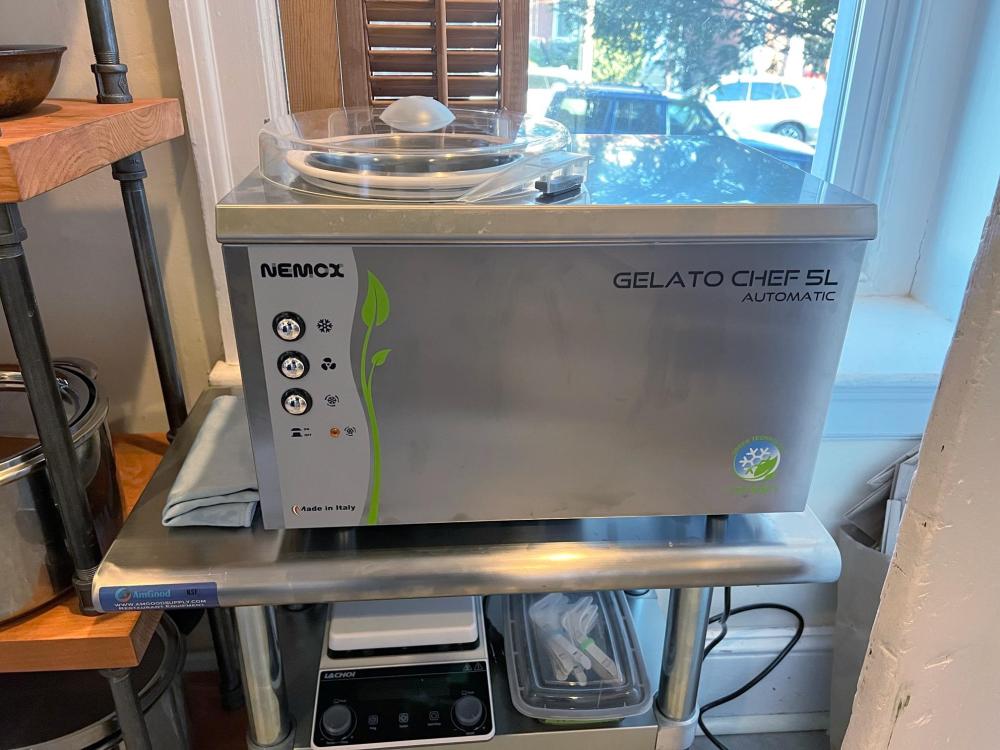-
Posts
5,172 -
Joined
-
Last visited
Content Type
Profiles
Forums
Store
Help Articles
Everything posted by paulraphael
-
I've been using the Nemox Gelato Chef 5L for a couple of weeks now. A few batches, a few measurements. Just wrote an initial review. TL;DR: I'm keeping it!
-
I've tried it both ways and didn't get any salt or alcohol in the ice cream. But it may not matter ... I'm guessing I'll use it just with the fixed bowl. One advantage of alcohol is there's no real added cleanup. Just wipe it out and let it evaporate. Brine needs to be cleaned completely because of corrosion risk. But alcohol does add about 50 cents worth of cheap vodka to the cost of every batch.
-
It's got a fixed and removable bowl. Your choice. The removable one fits inside the fixed one, with a couple of ounces of conductive liquid poured in first (brine or alcohol). The stainless dasher has interchangeable plastic scraper blades; you swap blades when switching bowls, so the dasher always makes solid contact with the bowl. My first 2 batches were with the removable bowl; I think the performance compromises may not be worth any added convenience. I'll try the fixed bowl next. It typically goes for $2K. The distributor generously gave it to me for wholesale cost. These machines have little exposure in the US, and I told them I planned to write about it. Based on research, I'd probably have still bought bought at full price. But maybe not right now, and definitely not as cheerfully. I'll have much more to add after putting it to work a few more times.
-
I'll look out for this box, thanks. In the mean time I wrote an annoyed email to the company. Old man shakes fist at clouds. Less sodium ... maybe per teaspoon? Since there's also less salt?
-
Exact same story here. I bought the same box; it's just table salt. What does the actual kosher salt box look like now?
-
-
I used to buy this at Buon Italia. Lately I've been getting Afeltra from Eataly, just because it's easier for me to get to on public transport. Will have to see if the free delivery applies to Brooklyn. Have you compared this to the Eataly brands, in price / quality? Edited to add: I'm addicted to the Vesuvio shape.
-
While I think the quality of your product is what will keep you in business, the branding is going to be key to getting you started. Simply because there are so many companies (big, small, tiny) doing things that are essentially similar. People need a reason to take a risk on on a newcomer. My instinct is that your marketing / branding should be decidedly un-fancy. The idea isn't to invent a story or an image, but to to use your actual story. You hinted at it ... from Texas and from all over, landed in small town midwest, working by yourself, making these exquisite looking things in your kitchen far from any culinary capitol, etc.. I think you can find a story in there that's true to who you are, that's appealing, and that distinguishes you from the competition. It could be the difference between creating momentum and being dead in the water. Since professional marketing is expensive, you might be able to higher someone more as a consultant, for guidance. You can do most of the work yourself (a blog! Written by the actual chocolate maker. Excerpts from you on social. People love that). One piece of advice from someone who's done branding for startups: don't do too much up front. You don't want to rigidly define yourself now, because you want the freedom to adapt to the market as you grow. The business idea as you're imagining it might stagnate, but a subtle or not-so-subtle variation might be a hit. Don't let your early branding paint you into a corner.
-
I get velvety smooth nut butters with a vitamix. The secret, I've learned, is making sure your nuts are at least 60% total fat. If they fall below this, you'll probably have to add some oil. Also, toast them. Here's a guide: 40%–49% fat: Cashews Pine Nuts 50%–59% fat: Almonds Pistachios Black Walnuts 60-69% fat: Brazil Nuts Hazelnuts Hickory English Walnuts 70%+ fat: Macadamia Nuts Pecans Less than 5% fat: Chestnuts Lychee My favorite blend is equal parts almonds, walnuts, and pecans. Add 1% salt, 5% maple syrup. It always works, because even if the almonds are on the dry side, the pecans are more than oily enough to balance them. I keep a hand near the vents on the blender, and give it breaks if the air coming out feels hot. No need to brutalize the thing. One trick is to take the jar off the base and run the blender for a couple of minutes unloaded, so it's just spinning the fan. Also: ear plugs.
-
Do you have the newer version of KA attachment? The one with the vertical grooves on the outside of the bowl? It might just have a burlier dasher than the old model. Mine would never be able to handle that.
-

Stoves and Ovens: Wolf? Thermador? Bluestar? Viking?
paulraphael replied to a topic in Kitchen Consumer
I'm pretty sure that new Vikings have nothing in common with 30 year-old Vikings. -
I think I've posted about her story before. I also go around begging people not to buy Melinda's.
-
That's right ... not an issue at that temperature. It becomes a problem when you preheat a frying pan.
-
I don't know how significant lecithin is, but most of these products probably use an oil high in unsaturated fats, to make sure it stays liquid and thin at wide range of temperatures. These are oils that will polymerize when they oxidize—either from sitting around a long time or from high heat. Oil polymerizing on a teflon pan is bad news. You're basically seasoning as if it's cast iron. That polymer coating is hard to get off without likewise removing the teflon. There was a thread a while ago where someone said they had a chemical solution—something caustic enough to take off the oil gunk without harming the teflon. Maybe worth checking out. I'm inclined to try one of those refillable spray bottles, but don't know if they're designed to deal with oil polymerizing in the nozzle and the little pump. I'd want to know there's a good way to clean and dekunk the things.
-
I'm just wondering how the ones you use would do with a typical 2 – 3L pan. Something maybe 7" in diameter. Would I be wise to get something bigger, or would these be ok?
-
A reason to use a pot would be to get it up to temperature on the stove, and continue on the hot plate. I wonder if the lower temperature model has lower wattage and would be slower to heat a liter of ice cream mix. I have stainless-lined copper pans that are non-magnetic. I don't see why these wouldn't work. Any ferrous / induction-capable pan would be a problem because the stirrer would just stick to the pan, but I think the copper will work. Anyway, that's why I'm curious about a pan being stable.
-
Interesting. I use a Pro 600 which easily has enough torque to rip that plastic dasher to bits. My clutch just spun around making loud clicking noises, saving the dasher. I've actually filed the teeth on the clutch a bit to make it less slippy than it's supposed to be. Maybe I got the bowl even colder than I remember? What's your drawing temperature and residence time with the -22 bowl? Thanks! It's hard to get a sense of the scale of these. Do you think the base is big enough to be stable with something like a 3L saucepan? How much time does it take to heat ~1L of mix up to pasteurizing temps?
-
I love it pureed. It plays well with other flavors. Fennel is a favorite, so is garlic. I poach it first in water with some milk or cream. Then use as much of this liquid as needed to get the consistency right in the blender.
-
Staff note: This post and responses to it have been split from the Home Made Ice Cream (2015–) topic to maintain topic focus. Your KA could handle a batch with the bowl chilled this low? My freezer has a kind of blast mode (for rapidly freezing warm things). I tried it out, and it got the KA freezer bowl to maybe -25C. The ice cream froze so hard so quickly that the dasher stalled ... it has a clutch that's designed to slip if the torque gets too high, probably to keep the mixer from ripping the plastic dasher to bits. I ended up finishing the batch by taking the bowl off the mixer and turning the dasher with my hand. It was brutal! I'm not doing this again. What happened with your batch? Edited to add: can you talk more about your lab hot plate? I've been looking at these for a while now. What's its capacity?
-
I don't recommend using egg whites in the ice cream. Texture will always be better without them. Some things you can use the whites for: financier*, merengue, traditional chocolate mousse. I'm sure you'll get pages of advice on this. You probably also won't have to look too far for a health fanatic who throws out all their yolks—you should be able to work something out! Another option is to make ice cream without the yolks. I find traditional "Philadelphia-style" recipes lacking in god texture, but there are modern approaches that let you have the best of all worlds. Add some other stabilizing ingredients, and an alternative emulsifier, like lecithin or buttermilk. Personally, I prefer chocolate and fruit flavors without any yolk. Other flavors I never put in more than a couple of yolks per quart. *Financier is my favorite use for whites. You don't have to make the traditional form. Think of it as the ultimate pound cake batter. Bake in any kind of loaf pan, bundt pan, or muffin tin.
-
I made lapsang souchong tea ice cream, mostly for the smoke. It was more interesting than good. Nothing I tried pairing it with was especially amazing. As they always say, "further research is warranted."
-
If you can set the freezer you chill the bowl in to -4°F /-20°C, or even a bit lower, you can get extremely good results. I've had freezing times under 8 minutes. Lower is always better, all else being equal. You have to pay lots for a compressor machine with this kind of power.
-

Potential hazards of black plastic spatulas, etc.
paulraphael replied to a topic in Kitchen Consumer
Repercussions: https://arstechnica.com/health/2024/12/journal-that-published-faulty-black-plastic-study-removed-from-science-index/ "The publisher of a high-profile, now-corrected study on black plastics has been removed from a critical index of academic journals amid questions about quality criteria, according to a report by Retraction Watch." -
Or you can just dream about it ...







